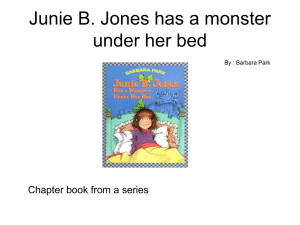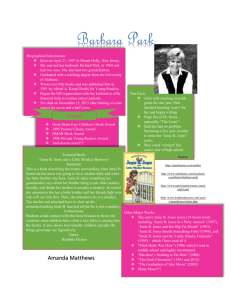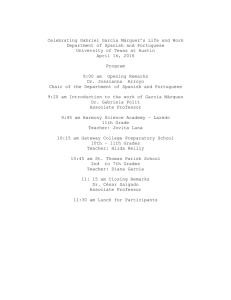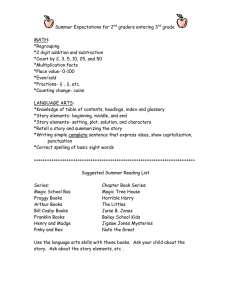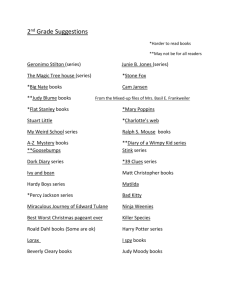Reimagining Home in the Río Puerco Valley - H-Net
advertisement
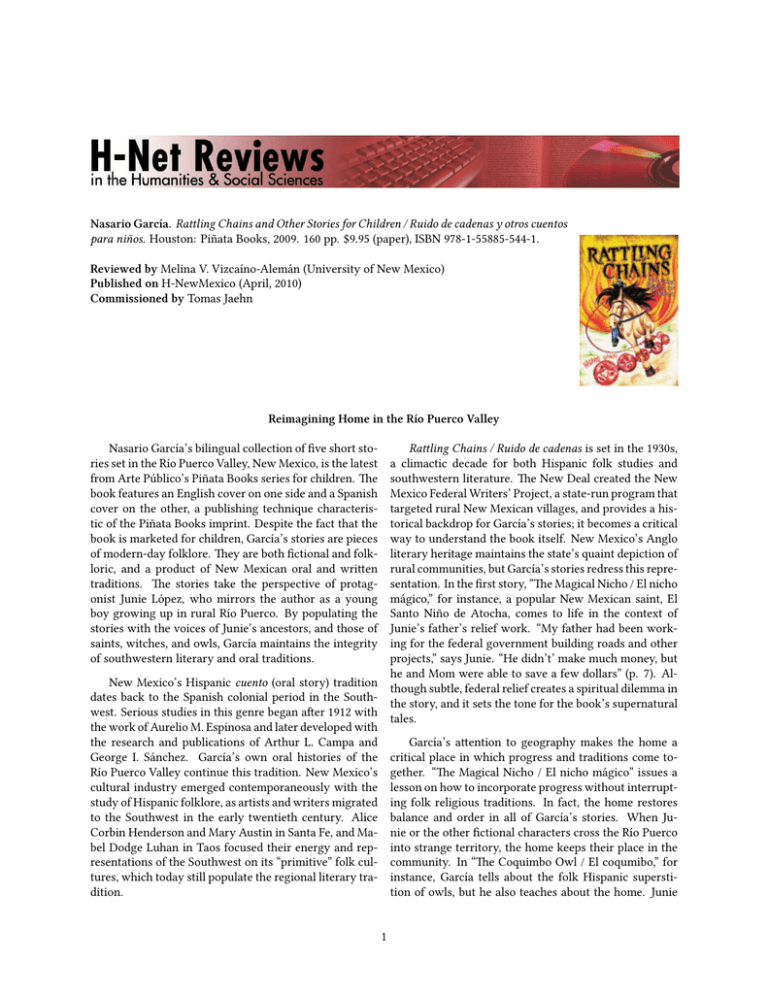
Nasario García. Rattling Chains and Other Stories for Children / Ruido de cadenas y otros cuentos para niños. Houston: Piñata Books, 2009. 160 pp. $9.95 (paper), ISBN 978-1-55885-544-1. Reviewed by Melina V. Vizcaíno-Alemán (University of New Mexico) Published on H-NewMexico (April, 2010) Commissioned by Tomas Jaehn Reimagining Home in the Río Puerco Valley Rattling Chains / Ruido de cadenas is set in the 1930s, a climactic decade for both Hispanic folk studies and southwestern literature. The New Deal created the New Mexico Federal Writers’ Project, a state-run program that targeted rural New Mexican villages, and provides a historical backdrop for García’s stories; it becomes a critical way to understand the book itself. New Mexico’s Anglo literary heritage maintains the state’s quaint depiction of rural communities, but García’s stories redress this representation. In the first story, “The Magical Nicho / El nicho mágico,” for instance, a popular New Mexican saint, El Santo Niño de Atocha, comes to life in the context of Junie’s father’s relief work. “My father had been working for the federal government building roads and other projects,” says Junie. “He didn’t’ make much money, but he and Mom were able to save a few dollars” (p. 7). Although subtle, federal relief creates a spiritual dilemma in the story, and it sets the tone for the book’s supernatural tales. Nasario García’s bilingual collection of five short stories set in the Río Puerco Valley, New Mexico, is the latest from Arte Público’s Piñata Books series for children. The book features an English cover on one side and a Spanish cover on the other, a publishing technique characteristic of the Piñata Books imprint. Despite the fact that the book is marketed for children, García’s stories are pieces of modern-day folklore. They are both fictional and folkloric, and a product of New Mexican oral and written traditions. The stories take the perspective of protagonist Junie López, who mirrors the author as a young boy growing up in rural Río Puerco. By populating the stories with the voices of Junie’s ancestors, and those of saints, witches, and owls, García maintains the integrity of southwestern literary and oral traditions. New Mexico’s Hispanic cuento (oral story) tradition dates back to the Spanish colonial period in the Southwest. Serious studies in this genre began after 1912 with the work of Aurelio M. Espinosa and later developed with the research and publications of Arthur L. Campa and George I. Sánchez. García’s own oral histories of the Río Puerco Valley continue this tradition. New Mexico’s cultural industry emerged contemporaneously with the study of Hispanic folklore, as artists and writers migrated to the Southwest in the early twentieth century. Alice Corbin Henderson and Mary Austin in Santa Fe, and Mabel Dodge Luhan in Taos focused their energy and representations of the Southwest on its “primitive” folk cultures, which today still populate the regional literary tradition. García’s attention to geography makes the home a critical place in which progress and traditions come together. “The Magical Nicho / El nicho mágico” issues a lesson on how to incorporate progress without interrupting folk religious traditions. In fact, the home restores balance and order in all of García’s stories. When Junie or the other fictional characters cross the Río Puerco into strange territory, the home keeps their place in the community. In “The Coquimbo Owl / El coqumibo,” for instance, García tells about the folk Hispanic superstition of owls, but he also teaches about the home. Junie 1 H-Net Reviews sneaks out of his grandma’s house and encounters a bruja (witch) disguised as an owl, so that, by the end, the home he escapes becomes a place of refuge. village itself has no name. Moreover, the only characters besides his own family to appear in these stories are mythical figures or people from the past, suggesting that Junie’s village suffered the fate of El Coruco and is now In the title story, García closes his short but delight- a ghost town. What comes to life is the Río Puerco, for ful collection with a supernatural tale that also serves the river marks the boundary between the familiar and as a lesson on the modern significance of ghost towns. the strange. Junie must learn how to cross and maintain Literally it is about “El Coruco” (chicken coop), “an enthose boundaries, as do the other fictional characters in chanted place where chains rattle,” but allegorically the the stories. As pieces of folklore, García’s stories teach story is about the author’s own rural home (p. 49). Junie about the past, but as fictional pieces they teach through begins telling the story, but his grandfather’s voice takes historical allegory about the present Río Puerco. over and he tells Junie two tales about fabled witches and bright lights in El Coruco. In one tale a fireball chases a García’s supernatural stories in Rattling Chains / man into the Río Puerco, and in the other a witch travels Ruido de cadenas reveal something about modernity in the sky in the form of a bright light. When Junie asks rural New Mexico, even as they resolve through historihis grandpa if the lights were like airplanes, he replies cal allegory the vanishing effects of progress. While the “No hijito. There were no planes back then” (p. 56). Yet book’s magic evokes a child’s imagination, it also beJunie’s question evokes the modern. Bright lights are a comes a folk lesson. The home establishes Junie’s place in supernatural force in grandpa’s story, but in Junie’s ex- the stories and in Río Puerco, but the stories themselves perience they are modern forces. As the first story re- give the author a place to reimagine his home in a modern veals, Junie’s father is a relief worker. At the end of the setting. The stories connect the supernatural to symbols collection, when Junie’s grandpa warns, “watch out for of progress to teach Junie a lesson about transgression the moving lights. They could be witches,” the book also and homecoming. Yet the collection itself transgresses issues a warning about progress (p. 61). fictional and folkloric boundaries so as to stage the author’s own homecoming. In the process, García modifies Though the stories take place during the 1930s, they the folk tradition using fictional tools that restore the rucarry a message about the present Río Puerco landscape ral home in the present, making Rattling Chains / Ruido and Junie’s home. Junie mentions his village to locate de cadenas and its lessons as relevant for today as in the his family’s ranch and his grandparents’ homes, but the past. If there is additional discussion of this review, you may access it through the network, at: https://networks.h-net.org/h-newmexico Citation: Melina V. Vizcaíno-Alemán. Review of García, Nasario, Rattling Chains and Other Stories for Children / Ruido de cadenas y otros cuentos para niños. H-NewMexico, H-Net Reviews. April, 2010. URL: http://www.h-net.org/reviews/showrev.php?id=26050 This work is licensed under a Creative Commons Attribution-NoncommercialNo Derivative Works 3.0 United States License. 2

